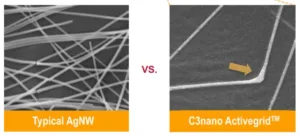The last time we took a serious look at technologies for replacing ITO in transparent conductors, Cambrios was the leading purveyor of silver nanowires (AgNWs). Cambrios was battling metal mesh technology to see who would lead in displacing ITO. But ITO refused to be displaced, and Cambrios found it had invested heavily to prepare itself for a market that was developing too slowly.

Cambrios, painfully, had to liquidate itself in a pennies on the dollar auction. And it was then that the calvary — the Taiwanese calvary — rode to the rescue. Leading touch-panel manufacturer TPK, which had been a customer of Cambrios, bought up the important pieces. Now, TPK is building fabs for manufacturing AgNW ink with the Cambrios technology and is investing heavily.
But with Cambrios now part of TPK, is there an opening for an independent AgNW producer, especially if has a technology it claims is superior to that of Cambrios?
Before it was ingested by TPK, Cambrios was not the only maker of silver-based inks for flexible, transparent conductors, even though it was the largest one. Others ran into the same problem as Cambrios (they were ready but the market wasn’t), and some interesting technologies went by the board. (TPK Will Produce Silver Nanowire Products – subscription required)
A small development-stage company — C3Nano — continued to develop its technology and is now sampling its ink and preparing for pilot roll-to-roll film manufacturing. (See C3nano Buys Silver Nanowire Maker, C3Nano and Nissha Partner on Silver Nanowire Conductive Film and Silver Nanowires Get Large – subscription needed for our previous coverage)The company’s novel IP is for Activegrid ink, which incorporates materials that are attracted to the places where the AgNWs cross as the ink is tried. They effectively weld the AgNWs where they cross, producing much better conductivity, even with a lesser concentration of AgNWs. This produces less haze in bright ambient conditions than is true of conventional AgNW solutions. The process depends on a sophisticated system that depends on reduced surface free energy at the crossing points. To simplify things for non-chemists, the company calls it Nanoglue Technology.
C3Nano reduces the resistance between nanowires.
Other than haze, transparent conductors are characterized by their bendability and their trade-off between optical transmissivity and conductivity. You would certainly like to have a conductive film that simultaneously has very low sheet resistance and and very high transmissivity, but the two trade off against each other. C3Nano’s Nanoglue permits a lower density of AgNWs which permits a high transmissivity as well as low haze. C3Nano says Activegrid has a sheet resistance of between 30 and 100 ohms/square, as compared to 50 to 100 for conventional AgNW technologies. Activegrid transmittance is 90-92%, compared to 89-91% for conventional, and haze is 0.2-1.0% compared to 0.8-1.5% for conventional. These optical properties include the substrate.
Although the news of ITO’s death has been exagerated, projections for the market penetration of ITO replacements finally look encouraging. Penetration was less than 20% in 2017, but should reach 50% in 2021 and rise thereafter, according to a 2016 Touch Display Research report.
So, does all of this look good to investors? In a word, yes. C3Nano had a goal of $10 million for its Series D equity financing round this summer, and wound up with $21 million. Among the investors is Nissha Printing, which C3Nano calls a “key development partner for advanced touch sensor films.” Hitachi Chemical is another partner.
This is interesting. We’ll keep an eye on C3Nano and let you know what we see. – Ken Werner
Ken Werner is Principal of Nutmeg Consultants, specializing in the display industry, manufacturing, technology, and applications, including mobile devices and television. He consults for attorneys, investment analysts, and companies re-positioning themselves within the display industry or using displays in their products. He is the 2017 recipient of the Society for Information Display’s Lewis and Beatrice Winner Award. You can reach him at [email protected].

